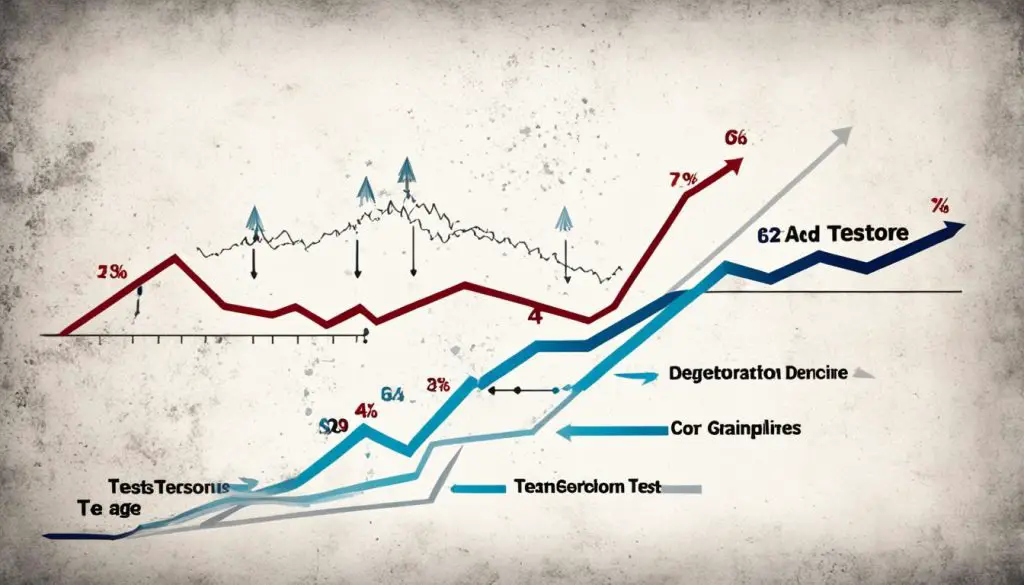Ad Blocker Detected
Our website is made possible by displaying online advertisements to our visitors. Please consider supporting us by disabling your ad blocker.
Welcome to our article on understanding age-linked testosterone decline in men. If you’ve ever wondered at what age men’s testosterone starts to drop and the impact it can have on overall health and well-being, you’re in the right place. In this article, we will delve into the key aspects of male testosterone decline, including symptoms, factors contributing to its decline, effects on the body, and treatment options. So let’s dive in!
Key Takeaways:
- Testosterone levels naturally decline with age in men.
- Symptoms of testosterone decline can include fatigue, reduced libido, and decreased cognitive function.
- Factors such as chronic illnesses, medication, obesity, and lifestyle choices can contribute to testosterone decline.
- Low testosterone levels can lead to decreased muscle mass, increased body fat, and decreased bone density.
- Lifestyle changes like regular exercise, maintaining a healthy weight, and managing stress can help maintain testosterone levels.
Symptoms of Testosterone Decline in Men
The symptoms of aging and hypogonadism can overlap, making the clinical diagnosis of hypogonadism in aging men challenging. Symptoms of testosterone decline include tiredness, lack of energy, reduced strength, frailty, loss of libido, decreased sexual performance, depression, mood changes, and potential cognitive impairment. These symptoms can greatly impact the quality of life in aging men.
Signs of Low Testosterone in Men:
- Tiredness and lack of energy
- Reduced strength and frailty
- Loss of libido and decreased sexual performance
- Depression and mood changes
- Potential cognitive impairment
Recognizing these signs is crucial in identifying potential testosterone decline. If you’re experiencing any of these symptoms, it’s important to consult with a healthcare professional for further evaluation and diagnosis.
Factors Contributing to Testosterone Decline
Testosterone levels naturally decrease as men age. This decline is a result of normal aging and can also be influenced by various factors. Understanding these factors is crucial in addressing testosterone decline in aging men and finding appropriate solutions.
Aging: As men get older, their testosterone levels naturally decrease. Studies have shown that total testosterone levels decline at an average rate of 1.6% per year, with free and bioavailable testosterone levels falling by 2-3% per year.
Chronic illnesses: Certain chronic illnesses can contribute to testosterone decline in men. Conditions such as diabetes, obesity, hypertension, and heart disease have been linked to lower testosterone levels.
Disease and debility: Illnesses or debility can also lead to testosterone decline in men. When the body is under stress due to illness or physical weakness, testosterone production may be affected.
Medications: Some medications, such as corticosteroids and opioid medications, can interfere with testosterone production and lead to lower levels in men.
Obesity: Excess body weight, particularly in the form of obesity, can contribute to testosterone decline. Fat cells convert testosterone to estrogen, leading to lower testosterone levels in men.
Lifestyle choices: Poor lifestyle choices, such as lack of exercise and unhealthy nutrition, can also cause testosterone decline. Regular exercise, a balanced diet, and maintaining a healthy weight are important for optimal testosterone levels.
Key takeaways:
- Testosterone levels naturally decline with age in men.
- Factors contributing to testosterone decline include aging, chronic illnesses, certain medications, obesity, and lifestyle choices.
- Understanding these factors is crucial in addressing testosterone decline and finding appropriate solutions.
Now that we’ve explored the factors causing testosterone decline in men, let’s take a closer look at the effects of low testosterone in males in the next section.

Effects of Low Testosterone in Males
Low testosterone levels can have numerous effects on males. These include:
- Decreased muscle mass and strength: Low testosterone can contribute to a reduction in muscle mass and strength, making it more difficult to perform physical tasks and engage in exercise.
- Increased body fat: Low testosterone levels are associated with an increase in body fat, particularly around the abdomen. This can lead to weight gain and a higher risk of obesity.
- Reduced bone density: Testosterone plays a crucial role in maintaining bone health. Low testosterone can result in decreased bone density, increasing the risk of osteoporosis and fractures.
- Decreased libido and sexual function: Testosterone is vital for sexual desire and performance. Low levels of testosterone can lead to a decrease in libido, erectile dysfunction, and other sexual problems.
- Decreased cognitive function: Testosterone influences cognitive function, including memory, concentration, and overall mental sharpness. Low testosterone levels may result in cognitive decline and difficulties with memory and focus.
- Fatigue: Low testosterone can cause persistent fatigue and a lack of energy, making it challenging to perform daily activities and affecting overall productivity.
- Depression and mood changes: Testosterone plays a role in mood regulation, and low levels can contribute to feelings of depression, irritability, and mood swings.
These effects can have a significant impact on overall well-being and quality of life.

Treatment Options for Low Testosterone
“Testosterone replacement therapy is a potential treatment option for men with clinically diagnosed low testosterone levels. However, the decision to undergo testosterone treatment should be based on a balance of risks and benefits. Testosterone therapy can have potential benefits on sexual function, mood, strength, and quality of life. It is important to work with a healthcare professional to assess individual needs and determine the most appropriate course of treatment.”
| Effect of Low Testosterone | Treatment Options |
|---|---|
| Decreased muscle mass and strength | Strength training exercises, testosterone replacement therapy |
| Increased body fat | Regular exercise, healthy diet |
| Reduced bone density | Weight-bearing exercises, calcium and vitamin D supplementation |
| Decreased libido and sexual function | Testosterone replacement therapy, lifestyle modifications |
| Decreased cognitive function | Cognitive exercises, hormone replacement therapy |
| Fatigue | Improved sleep quality, stress management |
| Depression and mood changes | Talk therapy, antidepressant medication, hormone therapy |
Maintaining Testosterone Levels Through Lifestyle Changes
As men age, a decline in testosterone levels is a natural part of the aging process. However, there are certain lifestyle changes that can help maintain optimal testosterone levels and support overall well-being.
Regular exercise and strength training play a crucial role in stimulating testosterone production and preserving muscle mass. Engaging in activities such as weightlifting, resistance training, and high-intensity interval training (HIIT) can have a positive impact on testosterone levels. Aim for at least 150 minutes of moderate-intensity aerobic activity or 75 minutes of vigorous activity per week, in addition to muscle-strengthening exercises two or more days a week.
Maintaining a healthy weight is also important for testosterone regulation. Excess body fat, especially around the abdomen, can contribute to lower testosterone levels. Focus on maintaining a balanced diet rich in lean proteins, whole grains, fruits, and vegetables. Avoid crash diets or severe calorie restrictions, as these can negatively affect hormone levels.
Managing stress levels is essential for testosterone maintenance. Chronic stress can lead to increased cortisol production, which can interfere with testosterone production. Incorporate stress-reducing techniques such as mindfulness, meditation, yoga, or other activities that help relax and calm the mind.
Avoiding excessive alcohol consumption is another lifestyle change that can support healthy testosterone levels. Alcohol can inhibit testosterone production and affect hormone balance. Moderation is key, and it is recommended to limit alcohol intake to no more than one drink per day for men.
Getting enough quality sleep is crucial for overall hormonal balance, including testosterone levels. Aim for 7-9 hours of uninterrupted sleep each night to support optimal testosterone production and regulation.
By making these lifestyle changes, you can help maintain healthy testosterone levels and promote overall well-being as you age. Remember, it’s essential to consult with a healthcare professional for personalized guidance and to address any specific concerns or health conditions related to testosterone levels.
Treatment Options for Testosterone Decline
As men age, testosterone levels naturally decline. For men with clinically diagnosed low testosterone levels, testosterone replacement therapy (TRT) is a potential treatment option.
TRT involves the administration of exogenous testosterone to restore hormone levels to normal. However, the decision to undergo TRT should be carefully evaluated. It is essential to consider the balance of risks and benefits associated with this treatment.
Testosterone therapy can offer several potential benefits, including:
- Improvement in sexual function and libido.
- Elevation of mood and overall well-being.
- Increase in strength and muscle mass.
- Enhancement of quality of life.
It’s crucial to work closely with a healthcare professional specializing in hormone therapy to assess your individual needs and determine the most appropriate course of treatment. They will consider factors such as your age, overall health, and lifestyle to develop a personalized treatment plan.

Before initiating any treatment, it’s important to undergo a comprehensive evaluation and have your testosterone levels accurately measured. This will provide a baseline and help monitor the effectiveness of the therapy over time.
“Testosterone therapy has been shown to significantly improve sexual function, mood, and overall well-being in men with clinically diagnosed low testosterone levels.”
While TRT can offer significant benefits, it’s essential to understand that it may also have potential risks and side effects. These can include acne, increased red blood cell count, fluid retention, breast enlargement, and in some cases, prostate issues. Your healthcare professional will closely monitor your response to the treatment and make adjustments as necessary to ensure optimal results.
| Treatment Option | Brief Description |
|---|---|
| Testosterone Injections | Injected intramuscularly every 1-2 weeks to maintain stable levels of testosterone. |
| Testosterone Gels/Patches | Applied daily to the skin, allowing for a consistent release of testosterone into the bloodstream. |
| Testosterone Pellets | Implanted under the skin, delivering a slow and steady release of testosterone over a period of several months. |
It’s important to be aware that TRT is not recommended for men with normal testosterone levels or those seeking performance enhancement. Only individuals with clinically diagnosed low testosterone levels should consider this treatment option.
Working closely with a knowledgeable healthcare professional will ensure that you receive the appropriate treatment for your unique situation, helping you optimize your testosterone levels and regain vitality.
Addressing Testosterone Decline with Medical Intervention
If you’re experiencing symptoms of low testosterone or have clinically diagnosed low testosterone levels, it may be necessary to consider medical intervention. One common method of addressing testosterone decline is through testosterone replacement therapy.
Testosterone replacement therapy can be administered using various methods such as gels, injections, patches, or pellets. These treatments aim to restore testosterone levels to a more optimal range and alleviate the symptoms associated with testosterone decline.
Working with a healthcare professional is crucial in determining the appropriate intervention for your specific needs. They will consider factors like your average age for testosterone decline, the factors causing your testosterone decline, and the severity of your symptoms before recommending a treatment plan.
It’s important to note that testosterone replacement therapy may not be suitable for everyone. Your healthcare professional will assess the potential risks and benefits of the treatment based on your individual health status and medical history.
“Testosterone replacement therapy can help address the symptoms of low testosterone and improve overall well-being.”
Testosterone Replacement Therapy Methods
There are various methods of administering testosterone replacement therapy:
- Gels: These are topical formulations that are applied directly to the skin, usually on the shoulders or upper arms. The testosterone is absorbed through the skin and into the bloodstream.
- Injections: Testosterone can be injected directly into the muscle, typically in the buttocks. This method allows for a longer-lasting effect.
- Patches: Testosterone patches are applied to the skin, usually on the back, abdomen, thighs, or upper arms. The patches release testosterone slowly into the bloodstream.
- Pellets: Small pellets containing testosterone are inserted under the skin, typically in the buttocks. The pellets slowly release testosterone over time.
These different methods offer flexibility in how testosterone replacement therapy is administered, allowing individuals to choose the option that best suits their preferences and lifestyle.
Monitoring Your Progress
Once you begin testosterone replacement therapy, it’s important to monitor your progress closely. Regular follow-up appointments with your healthcare professional will help ensure that your testosterone levels are within the desired range and that the treatment is effective.
During these check-ups, your healthcare professional may order blood tests to assess your testosterone levels and make any necessary adjustments to your treatment plan. They will also evaluate your symptoms and overall well-being to determine the effectiveness of the therapy.
By actively participating in your treatment and communicating any changes or concerns to your healthcare professional, you can work together to optimize your testosterone levels and improve your quality of life.
| Testosterone Replacement Therapy Methods | Pros | Cons |
|---|---|---|
| Gels | – Convenient application – Absorbed through the skin – No injections required |
– Potential skin irritation – Risk of transfer to others through skin contact |
| Injections | – Long-lasting effect – Cost-effective option |
– Requires regular injections – Risk of injection site discomfort |
| Patches | – Easy application – Slow release of testosterone – No injections required |
– Potential skin irritation – Limited placement options |
| Pellets | – Longer-lasting effect – No frequent application required |
– Requires minor surgical procedure for insertion – Risk of infection or extrusion |
Conclusion
As men age, it is vital to understand the natural timeline of testosterone decline and the signs and effects of this change. Low testosterone levels can have significant impacts on physical, sexual, and cognitive function, as well as overall quality of life.
If you are experiencing signs of low testosterone, such as tiredness, lack of energy, reduced strength, decreased libido, or mood changes, it is important to recognize these symptoms. Seeking appropriate medical intervention, such as testosterone replacement therapy, can help address the effects of testosterone decline and improve your overall well-being.
By working with a healthcare professional, you can determine the most suitable treatment options and monitor your progress. Remember, maintaining optimal testosterone levels is essential for maintaining your vitality and maximizing your quality of life as you age.
FAQ
At what age does men’s testosterone drop?
Testosterone levels naturally decline with age, typically starting in the late 30s or early 40s. However, the rate and extent of decline can vary among individuals.
What are the signs of low testosterone in men?
Common symptoms of low testosterone include fatigue, reduced strength, decreased libido, decreased sexual performance, mood changes, depression, and potential cognitive impairment.
What factors contribute to testosterone decline in men?
Testosterone levels can be affected by normal aging, chronic illnesses, certain medications, obesity, and lifestyle choices such as lack of exercise and poor nutrition.
What are the effects of low testosterone in males?
Low testosterone levels in men can lead to decreased muscle mass and strength, increased body fat, reduced bone density, decreased libido and sexual function, decreased cognitive function, fatigue, depression, and mood changes.
How can men maintain testosterone levels through lifestyle changes?
Regular exercise, especially strength training, maintaining a healthy weight, consuming a balanced diet high in protein, managing stress levels, avoiding excessive alcohol consumption, and getting enough sleep can help maintain optimal testosterone levels.
What are the treatment options for testosterone decline?
Testosterone replacement therapy is a potential treatment option for men with clinically diagnosed low testosterone levels. However, the decision to undergo testosterone treatment should be based on a balance of risks and benefits.
How can testosterone decline be addressed with medical intervention?
If a man is experiencing symptoms of low testosterone or has clinically diagnosed low testosterone levels, medical intervention such as testosterone replacement therapy may be necessary. The appropriate intervention and monitoring should be determined by a healthcare professional.
How does testosterone decline affect men?
Testosterone decline can have significant impacts on physical, sexual, and cognitive function, as well as overall quality of life. Recognizing the symptoms and seeking appropriate medical intervention can help address these effects.
– How Does Age-Linked Testosterone Decline in Men Affect Average Testosterone Levels?
As men age, their bodies naturally produce less testosterone, leading to a decline in average testosterone levels. This can result in decreased muscle mass, lower libido, and reduced energy levels. While this decline is a normal part of aging, it can impact overall health and wellness. Understanding average testosterone levels explained is crucial for men’s health.
How Does Age-Linked Testosterone Decline Affect Men’s Health and Well-being?
Age-linked testosterone decline can have a significant impact on men’s health and well-being. The effects of low testosterone can lead to reduced muscle mass, decreased energy levels, and decreased libido. It can also increase the risk of osteoporosis and depression. Seeking medical advice for proper evaluation and treatment is essential.


